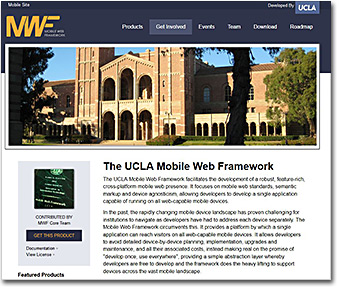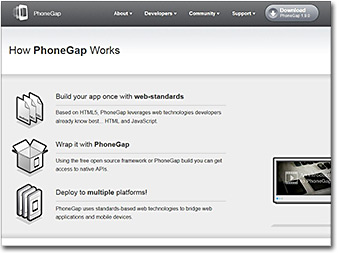 |
| MWF mobile framwork |
|
 |
| Phonegap |
|
As web-enabled phones or devices are becoming popular, students and instructors are getting used to utilize their mobile devices for daily online activities. Mobile devices are proliferating fast and it makes building applications for mobile devices face many new challenges. Designed to solve the proliferation issues and hardware differences of mobile devices, some mobile web frameworks may help developers to build mobile applications to fulfill users’ new expectation.
Different Types of Frameworks
Despite the convenience that a native (i.e. device specific) mobile application could bring, it makes developing a native application for each mobile device impossible due to the fragmented and evolving nature of mobile devices. The following frameworks are designed with multi-platform and device-agnostic in mind.
Web application framework for mobile devices
- UCLA Mobile Web Framework (http://mwf.ucla.edu/)
a cross-platform framework for building websites with mobile web standards and support of graceful degradation to less capable devices.
Frameworks for building native mobile applications for various platforms
Development Tools for Mobile Development
Development for mobile web applications needs similar tools as that used for ordinary website development. Native mobile applications development, however, will need specific tools required by some mobile platforms. For example, a Mac with Xcode is required for building native applications for iOS platform. Some development tools provide emulation of a mobile device for developers to do testing.
Functionalities and Limitations
Although mobile frameworks provide many advantages, they do have their limitations.
- Most frameworks do not support cutting-edge functionalities which may have already been available in latest mobile devices
- Those frameworks will usually go for a common-denominator approach that may ignore some platform-specific features
- Applications built with those frameworks will not be as optimized or flexible as native applications
Examples of Using Different Frameworks and Other Technologies
UCLA revamped an ordinary web application into a mobile one by using their mobile framework. http://m.happenings.ucla.edu/
Apart from the mentioned frameworks above, other technologies can be used to further enhanced mobile applications. Below are just a few examples of those technologies.
http://jquerymobile.com/test/
http://dhtmlx.com/touch/samples/
http://dev.sencha.com/deploy/touch/examples/
Support on Mobile Devices
Ordinary web applications, which need to be further optimized for mobile access, are bound to have the following limitations in mobile access. Mobile devices are mainly available in the following platforms with different versions and hardware form factors.
- iOS
- Android
- Symbian
- RIM
- Windows Mobile
Limitations of Existing Applications on Mobile Devices
- Display and Resolution Problem
As screens of mobile devices are usually smaller than that of desktop monitors, if web applications are not optimized for mobile devices, the display may not render properly on such devices. Users will need to scroll to view different areas of a webpage.
- Bandwidth Usage
Mobile applications usually come with simplified interfaces that make the pages faster to render. The bandwidth usage will be smaller than that of an ordinary web application. To conserve bandwidth usage, applications will need to be simplified and optimized for mobile device.
- Functionality Restrictions
Some functions that are supported in desktop browsers will not be supported in some mobile devices (e.g. file upload and support of Flash in iPhone and iPad)
Usage Statistics of LMES
The following charts show a summary of usage statistics of LMES with different operating systems and mobile devices. Windows platform is still the most popular operating system whereas the most popular mobile platforms are iOS (iPhone, iPod Touch and iPad) and Android. The mobile devices accounted for more than 14% of the total visits of LMES.
Direction to go forward
LMES and SFQ systems will be gradually optimized for mobile devices. The usage of a native application will also be explored to see how it would benefit users. |